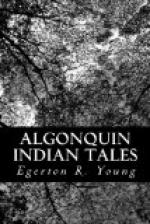But even all these things at length lost their interest. The flights of the wild geese, swans, and ducks had all ceased. They, with many other kinds of migrating birds, were busy nesting. The sweet songsters around the home were everyday companions, and, while the children loved them as much as ever, the excitement of their coming had died away. So when one day they saw Souwanas coming over the now sparkling waters in his canoe they were delighted to welcome him. As usual, when he reached the shore the contents of his canoe were examined speedily. There the children found a couple of beavers that had but lately been trapped, and a dozen or more muskrats that Souwanas had speared in the marshes. These animals were the result of one night’s hunting, and now Souwanas was on his way home to have them skinned and the pelts prepared for sale to the fur traders.
The children’s curiosity was much aroused by the sight of the beavers and muskrats, and they questioned the old man about them. The queer, broad, scaly tail of the beavers much interested them, and drew from Souwanas an interesting account of the various purposes for which the clever, industrious beavers use this apparently awkward appendage.
“Do you know any Nanahboozhoo stories in which he tells anything about beavers or muskrats?” asked Sagastao.
“Yes, indeed,” replied Souwanas; “in nearly all the stories that are told about the forming of the new land after the great flood both the beaver and the muskrat are mentioned, as well as the other animals.”
“Tell us one of the stories,” urged little Minnehaha.
The arrival of some other canoes at this point interrupted the conversation. The newcomers were on their way to the wigwam of Souwanas, who was their chief. He was about to go on with them, but when he saw the look of disappointment on the faces of the children he, with his usual thoughtful kindness, transferred the two beavers and the muskrats from his own canoe to one of the late arrivals. Then telling the people to give them to his wife, to have them all cooked and ready for dinner, by which time he would join them, he sent the people on their way. Having lighted his calumet, with the children seated near him, he began:
“Nanahboozhoo’s life commenced long before the great flood of waters that covered the earth, about which all of our tribes have heard something. He had his own wigwam and furnished it with everything he wanted. One day when walking on the shore of a great river he saw some sea lions lying on the sandy beach, basking in the sun. These animals, like the beaver, could live as well in the water as on the land. As he closely watched them from a distance, and saw the rich, shiny skins, he thought what a nice tobacco pouch could be made out of one of them. When Nanahboozhoo once set his heart on anything he at once began to work hard to secure it. He tried various plans to capture one of these sea-lions, but none of them succeeded.




